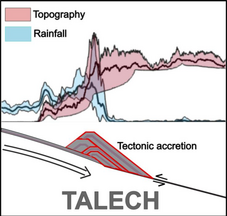TALECH (Tectonic Accretion, Landscape Evolution and Climate in the Himalaya)
Assessing how tectonic accretion affects the link between topography and orographic precipitation, and its role in the lateral growth of the Himalayan topography over geological timescales
The project employs a fully coupled numerical modeling framework that integrates three advanced models representing the system’s key components: ASPECT (a thermomechanical geodynamic model simulating tectonic deformation), FastScape (a landscape evolution model quantifying erosion, sediment transport, and surface response), and LFPM (a physics-based orographic precipitation model linking moisture transport with evolving topography).
By coupling these models, the research captures the two-way feedbacks between climate-driven surface processes and tectonic deformation. This integration provides new insight into how variations in basal accretion, ramp geometry, and cyclicity and precipitation patterns influence Himalayan topography, erosion rates, and landscape dynamics.
Through high-resolution simulations and systematic numerical experiments performed on NHR supercomputing clusters at the Zuse Institute Berlin, this work advances predictive capabilities for landscape evolution in active orogens. Ultimately, it contributes to a more unified understanding of tectonic–climatic feedbacks and the processes that shape Earth’s surface over million-year timescales.

Project duration: 2025-2026
Funding Agency: DAAD
PhD Student: Samantak Kundu
Project Team: Sascha Brune, Dirk Scherler, Sanjay Kumar Mandal (IISER Kolkata, India), Xiaoping Yuan (China University of Geosciences, Wuhan, China), Derek Neuharth